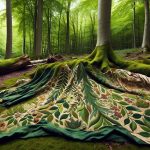You might not know that the textile industry is now experimenting with biodegradable polymers that can break down completely in natural environments. As you explore this trend, you'll discover how plant-based fibers like cotton and hemp are being complemented by innovative recycling techniques and natural dyes. The transformation of traditional methods to align with eco-conscious principles is more than just a trend; it's a significant shift. Curious about how these innovations are reshaping consumer choices and market dynamics? Let's discuss how these advancements are making a substantial impact on sustainability in fashion.
Table of Contents
Key Takeaways
- Emerging biodegradable polymers break down faster, reducing waste and pollution.
- Innovative recycling techniques like enzymatic breakdown and closed-loop systems promote sustainable fabric repurposing.
- Advances in natural dyes from eco-friendly sources enhance biodegradability and reduce environmental impact.
- Plant-based fibers like cotton and hemp offer renewable, sustainable alternatives for eco-conscious fashion.
- Market growth driven by consumer demand, brand initiatives, and stricter regulations supports biodegradable fabrics.
Plant-Based Fibers
Plant-based fibers, like cotton and hemp, offer eco-friendly alternatives to synthetic materials. By choosing these natural fibers, you're supporting sustainable agriculture and tapping into renewable resources.
Cotton, for instance, thrives with responsible farming methods, which reduce the need for harmful pesticides and heavy water usage. Hemp, on the other hand, grows rapidly with minimal input, making it an excellent choice for those looking to lessen their environmental footprint.
In the world of eco-conscious fashion, plant-based fibers shine as a beacon of ethical production. Brands committed to reducing their carbon footprint and promoting sustainability often turn to cotton and hemp. These fabrics not only biodegrade more naturally than synthetics but also offer durability and comfort, making them ideal for everyday wear. When you choose garments made from these fibers, you're making a statement for the planet.
Moreover, the cultivation and processing of plant-based fibers promote community well-being. Sustainable agriculture practices provide fair wages and safer working conditions for farmers. By supporting eco-conscious fashion, you're not just wearing a product; you're endorsing a system that values ethical production and the responsible use of renewable resources.
Innovative Recycling Techniques
You'll find that innovative recycling techniques are essential for sustainable fashion.
Advanced fiber recovery, enzymatic breakdown methods, and closed-loop recycling systems offer promising solutions.
Together, these techniques help transform waste into valuable resources with minimal environmental impact.
Advanced Fiber Recovery
Advanced fiber recovery techniques are revolutionizing the way we recycle biodegradable and compostable fabrics. By addressing textile waste head-on, these methods pave the way for a more efficient circular economy. You can now reclaim fibers from worn-out garments and transform them into high-quality materials for new products. This not only reduces environmental impact but also conserves resources.
To master these advanced fiber recovery techniques, consider the following key innovations:
- Mechanical Fiber Separation: This technique uses mechanical processes to separate fibers from blended fabrics without degrading their quality. It's a straightforward method that guarantees the longevity of recovered materials.
- Chemical Recycling: By breaking down fabrics into their chemical components, you can purify and reassemble fibers to create new textiles. This approach is particularly effective for dealing with complex blends that mechanical methods can't handle.
- Thermal Depolymerization: This advanced method converts polymer-based fabrics back into their monomer forms using heat. It's incredibly efficient for materials like polyester, allowing you to recover and reuse the base components in new applications.
Enzymatic Breakdown Methods
In addition to mechanical, chemical, and thermal methods, enzymatic breakdown offers a highly targeted approach to recycling biodegradable and compostable fabrics. By leveraging specific enzymes, you can achieve remarkable enzymatic efficiency, breaking down materials at a molecular level without the harsh chemicals that can harm the environment. This method not only preserves the biodegradable benefits of these fabrics but also ensures that their end-of-life processing aligns with eco-conscious principles.
When you focus on compostable fabrics, enzymatic breakdown stands out for its minimal environmental impact. Enzymes can be tailored to degrade specific polymers, making the process highly efficient and reducing the risk of unwanted by-products. This precision guarantees that the fabrics degrade into harmless substances, making them safe for composting and contributing to a circular economy.
Implementing enzymatic breakdown methods can markedly elevate your recycling game. It's not just about disposing of fabrics; it's about transforming them into valuable resources. By embracing these innovative techniques, you're not only addressing waste but also fostering a sustainable future.
Adopting enzymatic methods reflects a commitment to environmental stewardship and positions you at the forefront of eco-friendly textile recycling practices.
Closed-loop Recycling Systems
Closed-loop recycling systems revolutionize how we manage fabric waste by turning used materials back into new products, minimizing environmental impact. These systems are at the heart of the circular economy, ensuring that textiles aren't just discarded but continuously repurposed. By adopting these sustainable practices, you can greatly reduce your ecological footprint while maintaining product quality.
Here's how closed-loop recycling systems work effectively:
- Collection and Sorting: The first step involves collecting and categorizing textiles based on material type and quality. High-efficiency sorting technologies can distinguish between fibers, ensuring that only suitable materials enter the recycling process.
- Decomposition and Reformation: Once sorted, fabrics are decomposed into their basic fibers. Advanced chemical and mechanical processes then reform these fibers into new, high-quality threads, ready for manufacturing.
- Product Reintegration: The newly created fabrics are reintegrated into the production cycle, leading to new garments or textiles without the need for virgin materials, thereby conserving natural resources.
Advances in Natural Dyes
You'll find that recent advances in natural dyes offer eco-friendly sources and sustainable dyeing techniques. These developments not only reduce environmental impact but also enhance the biodegradability of fabrics.
Eco-Friendly Dye Sources
Recent developments in natural dyes offer a sustainable alternative to synthetic dyes, reducing environmental impact while maintaining vibrant colors. By harnessing the power of natural pigments, you're making a significant contribution to eco-conscious colors that benefit both the planet and your wardrobe.
Natural dyes come from a variety of sources, each with its unique benefits. Consider these three:
- Plant-Based Dyes: Derived from roots, leaves, flowers, and fruits, plant-based dyes offer a rich palette. Indigo, for example, provides stunning blues, while madder root gives you vibrant reds.
- Animal-Based Dyes: Though less common, some dyes come from insects like cochineal, which produces a brilliant red. These natural pigments have been used for centuries and continue to offer eco-friendly alternatives.
- Mineral-Based Dyes: Extracted from clay and minerals, these dyes provide earthy tones that are both durable and non-toxic. Ochre and iron oxides are classic examples that can be found in various shades.
Sustainable Dyeing Techniques
Innovative dyeing techniques now allow you to achieve vibrant colors sustainably while minimizing water and energy usage. With advances in natural dyes, you can now embrace waterless dyeing processes, which greatly reduce water consumption and pollution. Instead of traditional dye baths, these techniques utilize advanced machinery that applies non-toxic pigments directly onto fabrics.
One breakthrough method, known as supercritical CO2 dyeing, uses carbon dioxide in a supercritical state to dissolve and infuse dyes into textiles. This method eliminates the need for water entirely and drastically cuts down on energy usage. Additionally, it ensures that no harmful chemicals are released into the environment, making it a truly eco-friendly option.
Here's a quick comparison to help you understand the benefits:
| Traditional Dyeing | Waterless Dyeing |
|---|---|
| High water consumption | No water usage |
| Energy-intensive processes | Lower energy requirements |
| Potential chemical runoff | Non-toxic pigments |
| Multi-step procedures | Streamlined, efficient steps |
| Long drying times | Rapid drying processes |
Emerging Biodegradable Polymers
Scientists and engineers are developing a range of emerging biodegradable polymers that promise to revolutionize the textile industry. By focusing on biodegradable alternatives, polymer development is paving the way for fabrics that decompose naturally, reducing environmental impact. These innovations aren't just theoretical; they're already finding sustainable material applications in various sectors.
You might wonder why these new biodegradable polymers are so important. Here are three key factors:
- Environmental Impact: Traditional polymers often persist in the environment for centuries. Emerging biodegradable polymers break down more quickly, reducing waste and pollution.
- Resource Efficiency: These polymers can be sourced from renewable materials, ensuring a more sustainable lifecycle. This makes them ideal for future applications where resource conservation is essential.
- Functional Versatility: Advances in polymer development have led to materials that don't just degrade but also offer performance characteristics comparable to conventional fabrics, ensuring they meet industry standards.
Embracing these emerging biodegradable polymers isn't just a trend; it's a commitment to a more sustainable and responsible future for the textile industry. By understanding and adopting these innovations, you're contributing to a more eco-friendly world, ensuring that fashion and sustainability go hand in hand.
Traditional Methods Reinvented
Artisans and designers are infusing new vitality into traditional textile methods by integrating biodegradable materials and sustainable practices.
You're witnessing an exciting renaissance where age-old weaving, dyeing, and knitting techniques are paired with modern eco-friendly innovations. By incorporating upcycling techniques, these creators transform waste materials into valuable fabric, minimizing environmental impact while safeguarding cultural heritage.
Circular design concepts are at the core of this reinvention. Instead of following a linear model of production and disposal, you can now embrace a system where materials and products are continuously repurposed.
This approach not only extends the lifecycle of fabrics but also guarantees they return safely to the environment after use. Imagine garments designed to be disassembled, with each component either compostable or recyclable.
Market Adoption and Growth
As these sustainable practices gain traction, the market for biodegradable and compostable fabrics is experiencing significant growth. You're seeing an unprecedented surge in consumer demand, driven by a growing awareness of environmental impact. People want products that align with their values, and they're willing to pay a premium for eco-friendly options. This shift in consumer behavior is compelling brands to innovate and adopt sustainable practices.
Brands aren't just responding to consumer demand; they're also taking proactive steps through brand initiatives to lead the market. Companies are investing in research and development to create new materials that are both biodegradable and compostable. They're also launching marketing campaigns to educate consumers and highlight their commitment to sustainability.
Regulatory support is another critical factor accelerating market adoption. Governments worldwide are implementing stricter environmental regulations, which are pushing industries to adopt sustainable materials. This regulatory framework not only encourages but often mandates the use of eco-friendly fabrics.
Here are three key components driving market growth:
- Consumer demand: Increased awareness and willingness to invest in sustainable products.
- Brand initiatives: Companies leading through innovation and education.
- Regulatory support: Government policies enforcing the use of sustainable materials.
Embrace these trends to stay ahead in the evolving market landscape.
Frequently Asked Questions
How Do Biodegradable Fabrics Impact Soil Health?
By using biodegradable fabrics, you enhance soil health. These fabrics break down naturally, boosting soil fertility and microbial activity. You'll notice richer soil, which supports robust plant growth and a healthier ecosystem overall.
Are Biodegradable Fabrics More Expensive Than Conventional Ones?
Yes, biodegradable fabrics typically cost more than conventional ones. However, when you factor in cost comparison with their long-term environmental benefits, you'll see they're a worthwhile investment for sustainable living and ecological health.
Can Biodegradable Fabrics Be Washed Like Regular Clothes?
You can wash biodegradable fabrics like regular clothes, but you must follow specific washing instructions. Longevity concerns arise if you don't. Proper maintenance guarantees their durability, allowing you to enjoy their eco-friendly benefits longer.
What Certifications Ensure a Fabric Is Truly Biodegradable?
You'll want to look for certification standards like the OK Biodegradable and GOTS labels. These eco-friendly verifications guarantee the fabric's biodegradability, ensuring you're making a truly sustainable choice for your wardrobe.
How Do Compostable Fabrics Perform in Extreme Weather Conditions?
Imagine a fortress in a storm. Compostable fabrics, like that fortress, maintain durability and sustainability. While their performance in extreme weather is commendable, they gradually degrade, balancing resilience with their eco-friendly nature.
- What Is Percale Fabric Made Of? The Simple Answer - July 14, 2025
- What Is Egyptian Cotton Percale? The Gold Standard of Bedding - July 14, 2025
- What Is Cotton-Rich Percale? Understanding Fabric Blends - July 14, 2025






